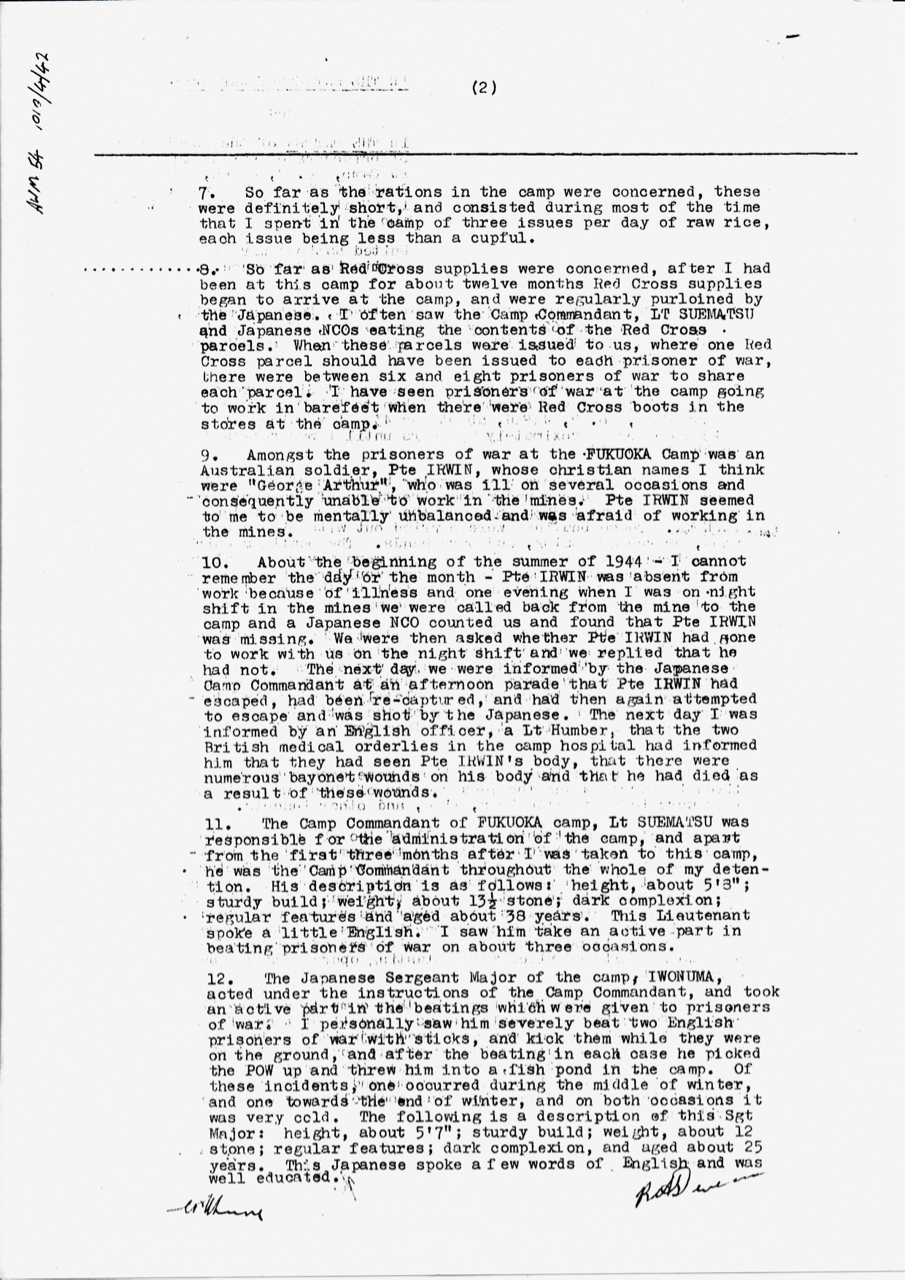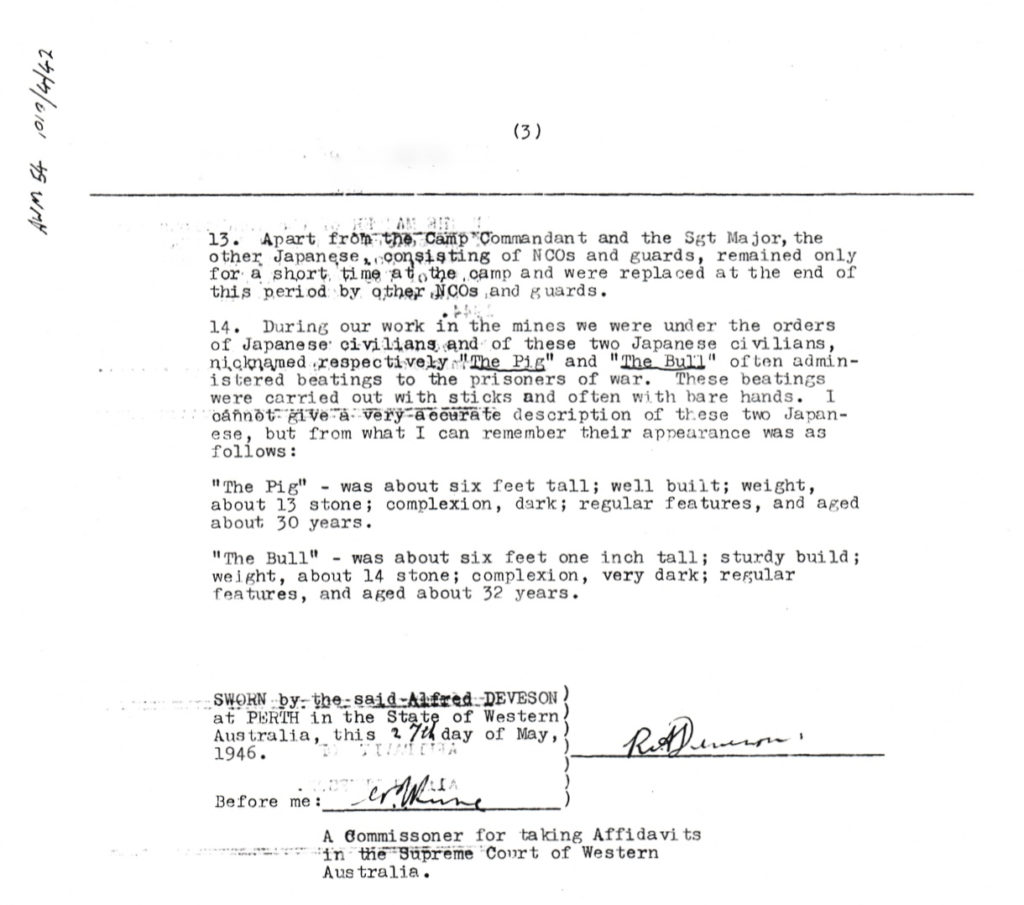The Soldier's Details

- Surname:
- Deveson
- First Name:
- Roy Alfred
- Nick Name:
- Curly
- Rank:
- Private
- Regimental #:
- WX6362
- Classification:
- Technical Storeman
- Company:
- ‘C’ Company Headquarters
- Enlisted:
- 16.07.1940
- Discharged:
- 12.12.1945
- DOB:
- 20.03.1920
- Place of Birth:
- Buckingham Mill near Collie, Western Australia
- Father's Name:
- Alfred James Deveson
- Mothers's Name:
- Emily Gertrude Victoria Deveson (nee Shepherdson)
- Religion:
- Church of England
- Pre-war Occupation:
- Factory Worker
- Singapore:
- Selarang Camp Changi; Thomson Road (Caldecot Hill Estate Camp); River Valley Road Camp; Selarang Barracks Chang ‘J’ Force Japan, Wales Maru Party
- Force:
- 'J' Force Japan, Wales Maru Party
- Camps Japan:
- Fukuoka sub-Camp No. 9 Hakensho
- POW#:
- 530 and 1067
- Return Details 1945:
- Nagasaki-Okinawa, US.Navy destroyer; Okinawa-Manila by aircraft; Manila-Sydney, HMS Formidable; Sydney-Perth by ANA aircraft
General Description
Roy was one of two sons and two daughters born to Alfred and Emily Deveson who married in 1913. Alfred was born in Alphington Victoria in 1893 and Emily was a Western Australian. The family resided at Buckingham Mill, near Collie where Alfred was employed as a timber worker. Alfred enlisted with the AIF on 2 October 1916, leaving behind his wife and eldest son Edward Oliver. After serving in France Alfred returned safely to Buckingham having been discharged 19 May 1919.
The family grew with the addition of daughters Edna and Gwen and lastly Roy in 1920.
With WW2 Edward Deveson enlisted with the RAAF. He tragically lost his life on a mission whilst flying over Netherlands on 2 March 1944. The Deveson’s probably did not know whether their youngest son Roy was alive. They had mostly likely been informed he was believed to be POW of the Japanese.
After the war in 1947, Roy married Noela Phyllis Abbott at Fremantle and it is believed they had one son.
________________
Curly was selected as a PoW in Singapore to work in Japan with ‘J’ Force. Most of those selected with ‘J’ Force had been hospitalised and were recovering – so really fit men!
Please read further about ‘J’ Force and ‘Wales’ Maru
Read about Fukuoka sub-Camp No. 9 Hakensho
In Singapore Roy Deveson was at the following camps:
Changi – Selarang 16 Feb 1942 to 15 Apr 1942
Thomson Road (Caldecot Hill Estate)15 Apr 1942 to 12 Dec 1942
Changi -12 Dec 1942 to 15 May 1943
He was admitted To AGH Sep 1942 with malaria, beri beri.
On 28 Mar 12943 he was admitted to AGH suffering amblyopia (impaired vision)
Roy was selected with J Force to work in Japan and sailed from Singapore on Wales Maru 15 May 1943 to Moji, Japan.
He worked at coal mining at Hakensho No. 9 from 7 June 1943 until he was recovered at the end of war on 16 September 1945
The following is taken from the Affidavit made by Roy Deveson, whose address at the time was given as 49 Oakover Street, East Fremantle who spent approximately 2 ½ years at Hashenko.
Hashenko Fukuoka No. 9 – By Roy Alfred Deveson WX6362
Their accommodation was about 200 yards from the coalmine. The POWs lived in barracks, which Deveson described as being of fair construction but infested with bugs, lice and other insects
There were regular beatings of POWs by Japanese NCOs and guards under the directions of Camp Commander Lieutenant Suematsu and Camp Sergeant Major Iwonuma. These beatings were always severe and carried out with pieces of wood or rubber hosing and bare hands were carried out daily. If the POW being beaten fell to the ground then several Japanese guards would kick him.
He personally witnessed on two occasions Suemastsu strike an English Sgt Major with his sheathed sword until he fell to the ground. In the winter of 1944 three Dutchmen were made to kneel in the snow, completely naked whilst Japanese guards poured buckets of cold water over them for approximately one hour.
On other occasions he personally witnessed Sgt. Major Iwonoma, under instructions from Camp Commandant, take active part in beatings. He saw him severely beat two English POWS with sticks until they fell to the ground and then kick them. After this he threw each prisoner into the fishpond at the camp. It was winter and very cold. He described Iwonuma as being about 25 years of age, well educated and able to speak some English.
Rations were poor and mostly consisted of three issues of raw rice per day, each issue being less than a cupful.
The mine was administered by Japanese civilians and POWs worked under their orders. Two of these civilians were nicknamed ‘The Pig’ and ‘The Bull’. ‘The Pig’ was about 6 feet tall, well built, about 13 stone and aged about 30 years. ‘The Bull’ was about 6’1” tall, sturdy build, about 14 stone and aged about 32 years. The civilian guards administered beatings with sticks and sometimes bare hands.
The mine conditions were not safe. The tunnels were not properly timbered and in certain parts there was not sufficient timber and in other areas the timber was rotten with decay. After blasting operations no inspection was made to ensure the tunnels were safe before POWs were sent back to work where blasting had taken place.
During those 2 ½ years there were five serious falls in the tunnels. An English POW received injuries resulting in a leg amputation; during another fall a Dutch POW sustained injuries requiring an arm amputation and several POWs sustained broken legs, arms and ribs during other falls.
12 months after arriving Deveson saw Red Cross supplies arrive for the first time. The Japanese regularly purloined them and he regularly saw the Camp Commandant Lt. Suematsu and NCOs eating contents of Red Cross parcels.
When Red Cross parcels were distributed, it was not one for each POW; instead they would receive one parcel for 6 to 8 POWs. POWs were going to work barefoot when Red Cross boots were in the camp store.
Amongst the POWs Deveson wrote of an Australian named Pte IRWIN (Christian names possibly George Arthur) who was ill on several occasions and unable to work. Deveson thought him to be mentally unbalanced and afraid of working in the mines.
During summer 1944 as the men returned from working night shift Irwin was found absent when counted by the NCO and the POWs confirmed he had not been with the work party.
The following day during afternoon parade the men were informed by the Camp Commandant that Irwin had escaped, been re-captured and then again attempted to escape and was shot by the Japanese.
The following day Roy Deveson was informed by an English officer, Lt. Humber that the two British orderlies working in the camp hospital informed him they had seen Pte Irwin’s body which had numerous bayonet wounds and that his death had resulted from such wounds.



Roy died 26 February 1990 at Hollywood Repatriation Hospital, Nedlands.
Roy’s wife Phyll of Oakover Street, East Fremantle wrote a letter of thanks to Assoc. for use of 2/4th Flag at Curly’s funeral and to thank all those members who attended. Curly never participated in 2/4th activities, however zealously read all the news contained in the Borehole Bulletins, and posted a donation. (Borehole Bulletin July 1990)
Camp Locations:
- River Valley Road Camp - Singapore
- Selarang Barracks Changi - Singapore
- Selarang Camp Changi - Singapore
- Thomson Road (Caldecot Hill Estate Camp) - Singapore
- Hakensho, Fukuoka sub-camp No9 - Japan




